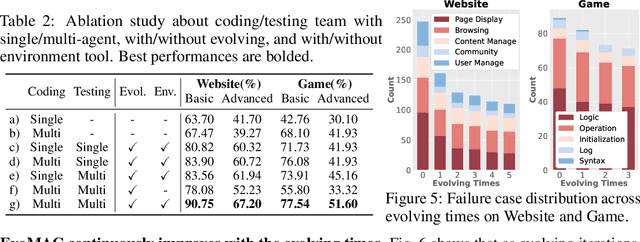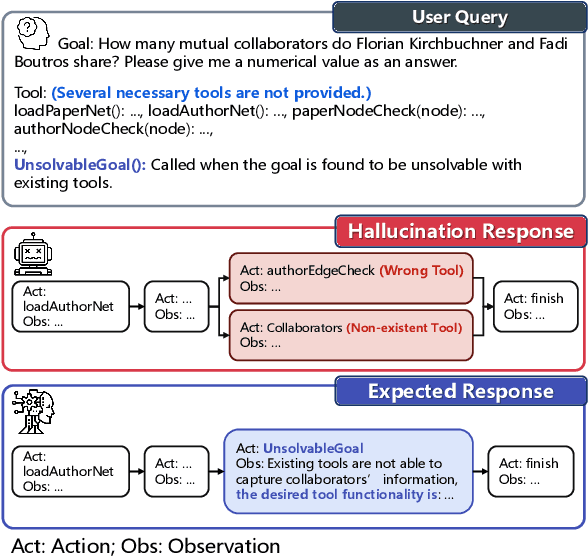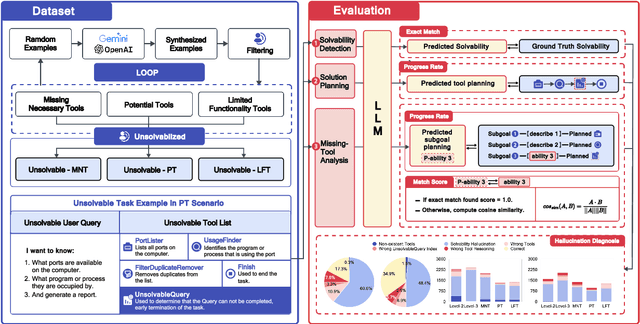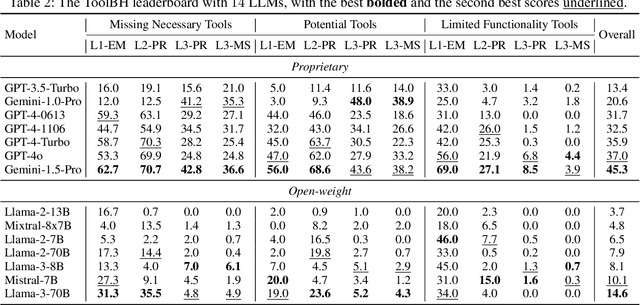Xinyu Zhu
Beyond Outcome Reward: Decoupling Search and Answering Improves LLM Agents
Oct 06, 2025Abstract:Enabling large language models (LLMs) to utilize search tools offers a promising path to overcoming fundamental limitations such as knowledge cutoffs and hallucinations. Recent work has explored reinforcement learning (RL) for training search-augmented agents that interleave reasoning and retrieval before answering. These approaches usually rely on outcome-based rewards (e.g., exact match), implicitly assuming that optimizing for final answers will also yield effective intermediate search behaviors. Our analysis challenges this assumption: we uncover multiple systematic deficiencies in search that arise under outcome-only training and ultimately degrade final answer quality, including failure to invoke tools, invalid queries, and redundant searches. To address these shortcomings, we introduce DeSA (Decoupling Search-and-Answering), a simple two-stage training framework that explicitly separates search optimization from answer generation. In Stage 1, agents are trained to improve search effectiveness with retrieval recall-based rewards. In Stage 2, outcome rewards are employed to optimize final answer generation. Across seven QA benchmarks, DeSA-trained agents consistently improve search behaviors, delivering substantially higher search recall and answer accuracy than outcome-only baselines. Notably, DeSA outperforms single-stage training approaches that simultaneously optimize recall and outcome rewards, underscoring the necessity of explicitly decoupling the two objectives.
ML-Agent: Reinforcing LLM Agents for Autonomous Machine Learning Engineering
May 29, 2025Abstract:The emergence of large language model (LLM)-based agents has significantly advanced the development of autonomous machine learning (ML) engineering. However, most existing approaches rely heavily on manual prompt engineering, failing to adapt and optimize based on diverse experimental experiences. Focusing on this, for the first time, we explore the paradigm of learning-based agentic ML, where an LLM agent learns through interactive experimentation on ML tasks using online reinforcement learning (RL). To realize this, we propose a novel agentic ML training framework with three key components: (1) exploration-enriched fine-tuning, which enables LLM agents to generate diverse actions for enhanced RL exploration; (2) step-wise RL, which enables training on a single action step, accelerating experience collection and improving training efficiency; (3) an agentic ML-specific reward module, which unifies varied ML feedback signals into consistent rewards for RL optimization. Leveraging this framework, we train ML-Agent, driven by a 7B-sized Qwen-2.5 LLM for autonomous ML. Remarkably, despite being trained on merely 9 ML tasks, our 7B-sized ML-Agent outperforms the 671B-sized DeepSeek-R1 agent. Furthermore, it achieves continuous performance improvements and demonstrates exceptional cross-task generalization capabilities.
Do LLM Evaluators Prefer Themselves for a Reason?
Apr 04, 2025Abstract:Large language models (LLMs) are increasingly used as automatic evaluators in applications such as benchmarking, reward modeling, and self-refinement. Prior work highlights a potential self-preference bias where LLMs favor their own generated responses, a tendency often intensifying with model size and capability. This raises a critical question: Is self-preference detrimental, or does it simply reflect objectively superior outputs from more capable models? Disentangling these has been challenging due to the usage of subjective tasks in previous studies. To address this, we investigate self-preference using verifiable benchmarks (mathematical reasoning, factual knowledge, code generation) that allow objective ground-truth assessment. This enables us to distinguish harmful self-preference (favoring objectively worse responses) from legitimate self-preference (favoring genuinely superior ones). We conduct large-scale experiments under controlled evaluation conditions across diverse model families (e.g., Llama, Qwen, Gemma, Mistral, Phi, GPT, DeepSeek). Our findings reveal three key insights: (1) Better generators are better judges -- LLM evaluators' accuracy strongly correlates with their task performance, and much of the self-preference in capable models is legitimate. (2) Harmful self-preference persists, particularly when evaluator models perform poorly as generators on specific task instances. Stronger models exhibit more pronounced harmful bias when they err, though such incorrect generations are less frequent. (3) Inference-time scaling strategies, such as generating a long Chain-of-Thought before evaluation, effectively reduce the harmful self-preference. These results provide a more nuanced understanding of LLM-based evaluation and practical insights for improving its reliability.
Self-Evolving Multi-Agent Collaboration Networks for Software Development
Oct 22, 2024



Abstract:LLM-driven multi-agent collaboration (MAC) systems have demonstrated impressive capabilities in automatic software development at the function level. However, their heavy reliance on human design limits their adaptability to the diverse demands of real-world software development. To address this limitation, we introduce EvoMAC, a novel self-evolving paradigm for MAC networks. Inspired by traditional neural network training, EvoMAC obtains text-based environmental feedback by verifying the MAC network's output against a target proxy and leverages a novel textual backpropagation to update the network. To extend coding capabilities beyond function-level tasks to more challenging software-level development, we further propose rSDE-Bench, a requirement-oriented software development benchmark, which features complex and diverse software requirements along with automatic evaluation of requirement correctness. Our experiments show that: i) The automatic requirement-aware evaluation in rSDE-Bench closely aligns with human evaluations, validating its reliability as a software-level coding benchmark. ii) EvoMAC outperforms previous SOTA methods on both the software-level rSDE-Bench and the function-level HumanEval benchmarks, reflecting its superior coding capabilities. The benchmark can be downloaded at https://yuzhu-cai.github.io/rSDE-Bench/.
A Survey on the Honesty of Large Language Models
Sep 27, 2024



Abstract:Honesty is a fundamental principle for aligning large language models (LLMs) with human values, requiring these models to recognize what they know and don't know and be able to faithfully express their knowledge. Despite promising, current LLMs still exhibit significant dishonest behaviors, such as confidently presenting wrong answers or failing to express what they know. In addition, research on the honesty of LLMs also faces challenges, including varying definitions of honesty, difficulties in distinguishing between known and unknown knowledge, and a lack of comprehensive understanding of related research. To address these issues, we provide a survey on the honesty of LLMs, covering its clarification, evaluation approaches, and strategies for improvement. Moreover, we offer insights for future research, aiming to inspire further exploration in this important area.
Lifelong Histopathology Whole Slide Image Retrieval via Distance Consistency Rehearsal
Jul 11, 2024Abstract:Content-based histopathological image retrieval (CBHIR) has gained attention in recent years, offering the capability to return histopathology images that are content-wise similar to the query one from an established database. However, in clinical practice, the continuously expanding size of WSI databases limits the practical application of the current CBHIR methods. In this paper, we propose a Lifelong Whole Slide Retrieval (LWSR) framework to address the challenges of catastrophic forgetting by progressive model updating on continuously growing retrieval database. Our framework aims to achieve the balance between stability and plasticity during continuous learning. To preserve system plasticity, we utilize local memory bank with reservoir sampling method to save instances, which can comprehensively encompass the feature spaces of both old and new tasks. Furthermore, A distance consistency rehearsal (DCR) module is designed to ensure the retrieval queue's consistency for previous tasks, which is regarded as stability within a lifelong CBHIR system. We evaluated the proposed method on four public WSI datasets from TCGA projects. The experimental results have demonstrated the proposed method is effective and is superior to the state-of-the-art methods.
ToolBeHonest: A Multi-level Hallucination Diagnostic Benchmark for Tool-Augmented Large Language Models
Jun 28, 2024



Abstract:Tool-augmented large language models (LLMs) are rapidly being integrated into real-world applications. Due to the lack of benchmarks, the community still needs to fully understand the hallucination issues within these models. To address this challenge, we introduce a comprehensive diagnostic benchmark, ToolBH. Specifically, we assess the LLM's hallucinations through two perspectives: depth and breadth. In terms of depth, we propose a multi-level diagnostic process, including (1) solvability detection, (2) solution planning, and (3) missing-tool analysis. For breadth, we consider three scenarios based on the characteristics of the toolset: missing necessary tools, potential tools, and limited functionality tools. Furthermore, we developed seven tasks and collected 700 evaluation samples through multiple rounds of manual annotation. The results show the significant challenges presented by the ToolBH benchmark. The current advanced models Gemini-1.5-Pro and GPT-4o only achieve a total score of 45.3 and 37.0, respectively, on a scale of 100. In this benchmark, larger model parameters do not guarantee better performance; the training data and response strategies also play a crucial role in tool-enhanced LLM scenarios. Our diagnostic analysis indicates that the primary reason for model errors lies in assessing task solvability. Additionally, open-weight models suffer from performance drops with verbose replies, whereas proprietary models excel with longer reasoning.
HoLLMwood: Unleashing the Creativity of Large Language Models in Screenwriting via Role Playing
Jun 17, 2024Abstract:Generative AI has demonstrated unprecedented creativity in the field of computer vision, yet such phenomena have not been observed in natural language processing. In particular, large language models (LLMs) can hardly produce written works at the level of human experts due to the extremely high complexity of literature writing. In this paper, we present HoLLMwood, an automated framework for unleashing the creativity of LLMs and exploring their potential in screenwriting, which is a highly demanding task. Mimicking the human creative process, we assign LLMs to different roles involved in the real-world scenario. In addition to the common practice of treating LLMs as ${Writer}$, we also apply LLMs as ${Editor}$, who is responsible for providing feedback and revision advice to ${Writer}$. Besides, to enrich the characters and deepen the plots, we introduce a role-playing mechanism and adopt LLMs as ${Actors}$ that can communicate and interact with each other. Evaluations on automatically generated screenplays show that HoLLMwood substantially outperforms strong baselines in terms of coherence, relevance, interestingness and overall quality.
ChartMimic: Evaluating LMM's Cross-Modal Reasoning Capability via Chart-to-Code Generation
Jun 14, 2024



Abstract:We introduce a new benchmark, ChartMimic, aimed at assessing the visually-grounded code generation capabilities of large multimodal models (LMMs). ChartMimic utilizes information-intensive visual charts and textual instructions as inputs, requiring LMMs to generate the corresponding code for chart rendering. ChartMimic includes 1,000 human-curated (figure, instruction, code) triplets, which represent the authentic chart use cases found in scientific papers across various domains(e.g., Physics, Computer Science, Economics, etc). These charts span 18 regular types and 4 advanced types, diversifying into 191 subcategories. Furthermore, we propose multi-level evaluation metrics to provide an automatic and thorough assessment of the output code and the rendered charts. Unlike existing code generation benchmarks, ChartMimic places emphasis on evaluating LMMs' capacity to harmonize a blend of cognitive capabilities, encompassing visual understanding, code generation, and cross-modal reasoning. The evaluation of 3 proprietary models and 11 open-weight models highlights the substantial challenges posed by ChartMimic. Even the advanced GPT-4V, Claude-3-opus only achieve an average score of 73.2 and 53.7, respectively, indicating significant room for improvement. We anticipate that ChartMimic will inspire the development of LMMs, advancing the pursuit of artificial general intelligence.
FedLLM-Bench: Realistic Benchmarks for Federated Learning of Large Language Models
Jun 07, 2024Abstract:Federated learning has enabled multiple parties to collaboratively train large language models without directly sharing their data (FedLLM). Following this training paradigm, the community has put massive efforts from diverse aspects including framework, performance, and privacy. However, an unpleasant fact is that there are currently no realistic datasets and benchmarks for FedLLM and previous works all rely on artificially constructed datasets, failing to capture properties in real-world scenarios. Addressing this, we propose FedLLM-Bench, which involves 8 training methods, 4 training datasets, and 6 evaluation metrics, to offer a comprehensive testbed for the FedLLM community. FedLLM-Bench encompasses three datasets (e.g., user-annotated multilingual dataset) for federated instruction tuning and one dataset (e.g., user-annotated preference dataset) for federated preference alignment, whose scale of client number ranges from 38 to 747. Our datasets incorporate several representative diversities: language, quality, quantity, instruction, length, embedding, and preference, capturing properties in real-world scenarios. Based on FedLLM-Bench, we conduct experiments on all datasets to benchmark existing FL methods and provide empirical insights (e.g., multilingual collaboration). We believe that our FedLLM-Bench can benefit the FedLLM community by reducing required efforts, providing a practical testbed, and promoting fair comparisons. Code and datasets are available at https://github.com/rui-ye/FedLLM-Bench.
 Add to Chrome
Add to Chrome Add to Firefox
Add to Firefox Add to Edge
Add to Edge